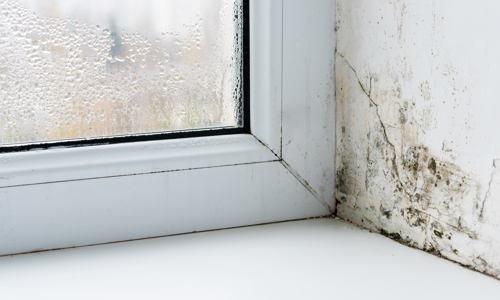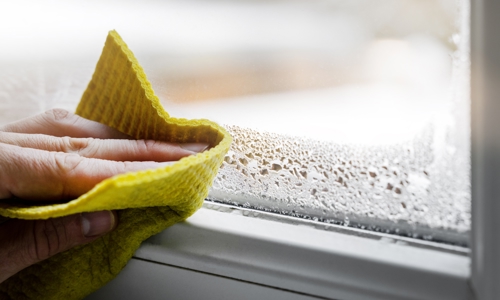Everyone deserves a home that’s safe, warm and comfortable.
That’s why we take damp and mould seriously – because it can affect your home, health and wellbeing.
Damp and mould are usually caused by too much moisture in the air from everyday things like boiling the kettle, drying clothes indoors or taking a shower. You might notice condensation on your windows, especially in winter – that’s completely normal.
But if the moisture builds up and can’t escape, it can lead to bigger problems.
How to report it
It’s super easy! Just give us a call on 0345 366 4404.
If you spot mould on your windows, ceiling or walls, damp patches behind furniture, or smell something musty, tell us straight away. The sooner you let us know, the quicker we can fix it.

What we'll do
We take every report seriously. Under Awaab’s Law, we’re committed to acting fast when there’s a risk to your health or safety - especially from damp and mould, but also others serious issues like gas leaks, broken boilers, electrical faults, and structural damage.
When you report a problem, we’ll ask a few quick questions to help us understand what’s going on. We’ll want to know about your health, where the issue is in your home and how severe it is.
This helps us decide whether it’s an emergency or significant hazard.
- Emergency hazards include things like damp and mould that’s affecting breathing. We’ll aim to visit within 4 hours, and always within 24 hours, to investigate and fix the issue or make it safe.
- Significant hazards include persistent damp and mould, condensation linked to poor ventilation, or mould in bedrooms and living areas that could worsen health. We’ll investigate within 10 working days, make your home safe within five, and complete any extra repairs within 12 weeks.
Our Awaab’s Law page explains more on how we assess risks, what counts as a hazard, and how quickly you can expect us to respond.
What to look out for
If windows, walls, or ceilings look foggy or wet, that’s a sign of too much moisture. It can lead to mould if it’s not sorted quickly.
Black spots or streaks near windows or up high usually mean mould. It’s not just unpleasant - it can affect your health.
If a room smells damp or like soil, it could mean there’s mould or hidden moisture. Don’t ignore strange smells - they’re often the first clue.
Brown, yellow, or dark patches on walls or floors might mean water damage. It’s a sign that damp is getting in somewhere.
If you find wet or cold patches behind sofas or inside cupboards, that’s a warning sign. Damp often hides in places you don’t look every day.
Mould in places where you sleep, wash, or relax needs fixing fast. Report it to us straightaway.
What you can do
These small actions can make a big difference:
- Keep your home heated between 18°C and 21°C, and try not to let it drop below 16°C for long periods, especially in colder months.
- Dry laundry indoors only in rooms with a running extractor fan, which helps remove moisture from the air.
- Wipe condensation off your windows each morning using a towel or kitchen roll. This is a normal sign that your home is warmer than the air outside, but it’s important to remove it before it builds up.
- If you’re enjoying a hot shower or bath, keep the door closed so your extractor fan can work properly and stop steam from spreading to other rooms.
- If your windows have trickle vents, keep them open all year round – unless the extractor fan is running, in which case it’s best to close them.
- If your windows don’t have trickle vents, open them slightly and lock them in the vent position to let moisture escape while keeping your home secure.
- Avoid using your loft for storage, as this can squash insulation and create cold spots where moisture gathers.
- Leave a few inches of space between your furniture and the walls to help air circulate and let your walls breathe.
Condensation
This is one of the most common causes of damp and mould in the home.
When moisture builds up and doesn’t have a way to escape, it can lead to serious problems over time – learn more about what causes it and how to manage it on our condensation advice page.

Looking for something else?
Our damp and mould page is full of tips to keep your home feeling its best this winter, but maybe you’re after something else…
